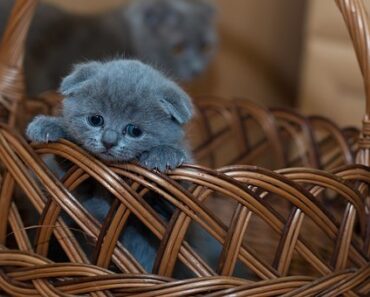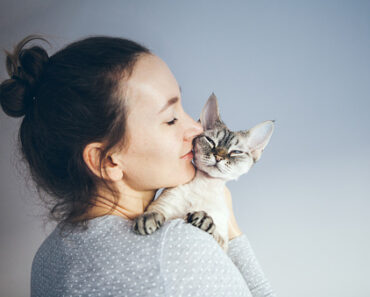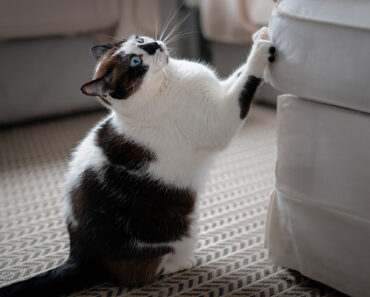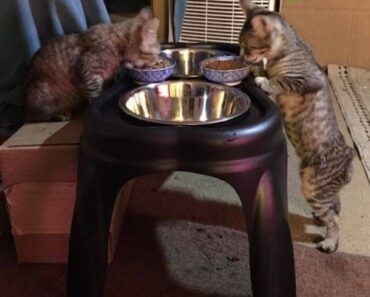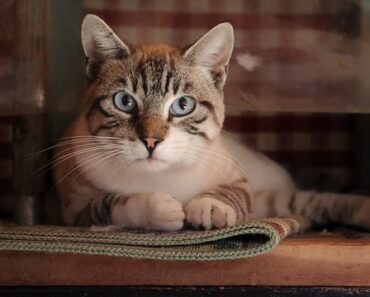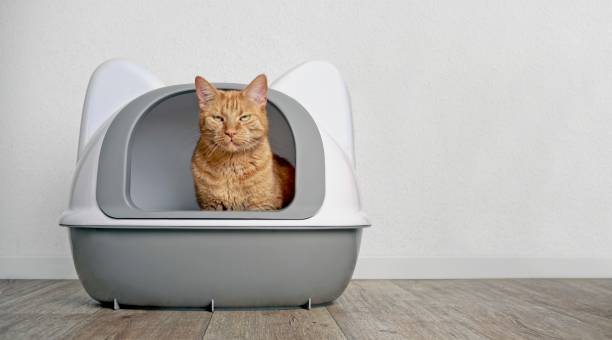
1. The simple litter box is still the most popular
For your cat’s comfort, there are two main types of cat litter boxes: the litter box and the litter box house. The litter box is the simplest reference: it is a plastic box with high edges. Totally open, it is a product that is not aesthetically pleasing to the owner, but often favored by felines.
As for the cat toilet house, similar to a house, it consists of a tray accessible through a cat flap and covered with a lid. It is an aesthetically pleasing product that offers privacy.
From the owner’s point of view, it is true that the toilet house seems to be the best choice: it looks good, hides excrements and urine and prevents bad smells from spreading too much. But the king is the cat, and if he doesn’t like his litter box, he’ll do his business elsewhere!
To be sure to make the right choice, we offer a wide range of litter boxes and toilet houses!
2. The litter box should not be cleaned too often
Cats like to find their scent, which is reassuring for them. You’ve probably noticed that when you clean the litter box, he rushes in to do his business. Since his scent was removed during the cleaning, he will try to put it back in as soon as possible. Therefore, you should not be maniacal and want to remove the excrement and urine at all costs as soon as the feline has done its business. Poop should be removed every day, while urine-soiled cat litter can be removed only every two to three days, the frequency of cleaning depending on how often your cat urinates. Finally, it also depends on the type of litter used.
3. The box should be in a high-traffic area
The litter box should be located in a quiet, accessible area. Even if it doesn’t seem very aesthetic and appetizing, you shouldn’t place your cat’s toilet in a noisy, high-traffic area or in a small, remote, forgotten corner of your home.
Be careful, however, to respect your cat’s 4 zones (feeding, playing, sleeping and litter box) by placing the litter box as far away as possible from the area where it feeds. Once you’ve found the ideal location, don’t change it!
4. Scented litter can confuse the cat
Using a scented litter box is nice for the family, because it tends to mask bad odors, but it’s much less pleasant for the cat! As mentioned earlier, cats like to have their own scent in their litter box. However, the scent of the litter box can overpower the cat’s own scent, causing some cats to miss their own scent or to smell a different scent in a place that is reserved for them. In extreme cases, they may have to relieve themselves in a corner of your home!
5. When a feline doesn’t like his litter box…
… he relieves himself elsewhere!
There are many reasons, other than medical, why cats can be messy.
First of all, the litter box or toilet house may not be suitable. Some cats like the privacy of a litter box, while others prefer to relieve themselves in the open air. Tip: If your cat doesn’t like the litter box, try removing the cat flap door or lid.
Finally, most often, the cat litter you choose may not be popular with your feline, especially if it is scented, noisy or hard on the pads. Once you’ve found a litter box that your cat is happy with, try not to change it, as cats are creatures of habit.
6. Plant-based litter can be flushed down the toilet
Vegetable litter is known to be made from a natural, biodegradable raw material. It can therefore be disposed of in the toilet or composted without any worries. This is a particularly nice feature for people who live in apartments or who don’t like to keep soiled litter in their homes with the odors that go with it!
7. Some cats will eat their litter box
If your cat is still young, don’t worry. It is advisable to educate him to not have this attitude and to make him understand that the litter box is not edible.
On the other hand, in the case of an adult cat that suddenly adopts this behavior, it must be taken seriously. Very often, this is observed with mineral litter: a cat that ingests it does so because it has a mineral deficiency or is anemic, as these litters contain iron. This is also seen in cats with pica or AIDS. Try changing the litter box and observe the behavior. But if the behavior persists, consult your veterinarian.
8. Newspaper should not be used as a regular litter box
Many owners use it as a litter box or as their primary litter, but newspaper is not recommended for several reasons: it is not comparable in performance to conventional cat litter, it is not absorbent and does not retain odors. Also, it requires daily maintenance. Finally, cat urine does not mix well with the inks and chemicals present in the newspaper. The mixture is notably toxic.
9. There are litters with a health indicator
Some silica litters or crystal litters have a “health indicator” function.
Its interest? When in contact with the cat’s urine, the silica crystals take on a particular color if a urinary anomaly is detected, for example blood in the urine, a non-conforming pH…
This product is particularly interesting for neutered males, senior cats or adult felines prone to urinary problems.
10. No household products to clean the box
Once again, it’s a question of perfume! Be aware that some household products have a strong odor that can easily bother your feline because they mask his own.
Also, some products are toxic for the cat and are thus to be proscribed for the cleaning of its direct environment.
Prefer natural products such as bicarbonate, white vinegar or black soap. Also, some brands are specialized in the hygiene of the animal environment, such as Saniterpen, and therefore offer products that are perfectly compatible for the maintenance of your cat’s litter box.

